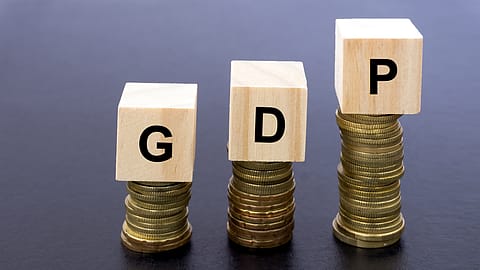Q2 GDP: Macro blues all encompassing
In Q2, gross fixed capital formation (GFCF) growth has less than halved to 5.4% compared with 11.6% growth in the second quarter of the previous financial year.

Three major macroeconomic concerns are very evident in the GDP growth data issued by the centre yesterday.
First, gross fixed capital formation in the economy, which has been the mainstay of growth over the last couple of years as other economic engines remained tepid, has slowly started waning.
Next, the entire secondary sector of the economy has gone for a toss with the growth rate getting reduced to less than a third in Q2, FY25 at 3.9% compared with 13.7% in Q2, FY24. Thirdly, the jump witnessed in agriculture growth in the quarter gets reduced to optics if seen in the context of how the sector fared in the first half of the current fiscal.
In Q2, gross fixed capital formation (GFCF) growth has less than halved to 5.4% compared with 11.6% growth in the second quarter of the previous financial year. GFCF is a measure of the investments into the fixed capital assets in the economy. It may be noted that the GFCF growth has been on a downward trajectory since the last four quarters. This is a disturbing aspect as spending on capital assets has been one of the key strategies of the government, which has kept the Indian economy upbeat since the COVID-19 pandemic.
“On the demand side, moderation in consumption and investment growth were a drag on GDP growth. The slowdown was sharper in investment, which was weighed down by continuing weakness in government capex. At the same time, consumption moderated with elevated borrowing costs and inflation eating into household budgets,” said the Crisil report titled Macroeconomics, First Cut, Signs of Trouble.
Capital expenditure trend points to more pain on the GFCF front in the coming quarters. Against the budget estimate (BE) of Rs 11,11,111 crore towards capital expenditure for the current financial year, the actual expenditure till October stands at Rs 4,66,545 crore, or 42% of the BE, 2024-25. Till October last year, the capex utilisation by the ministries was significantly higher at 54.7% of the budget estimate for 2023-24.
Led by manufacturing, the secondary sector of the economy came down crashing in the second quarter of the fiscal. Manufacturing registered a 2.2% growth in Q2, FY25 compared with 14.3% growth in the corresponding period of the previous financial year. Electricity, water supply, and other utility services also grew at 3.3% compared with 10.5%. Construction was the only saviour in the pack with 7.7% growth but was significantly down from the 13.6% growth witnessed in Q2 FY24.
Recommended Stories
“The construction sector’s growth moderated to 7.7% YoY in line with moderation in cement production, and steel consumption during the quarter. However it managed to avoid a sharper slowdown as a pick-up in infrastructure spending possibly provided some support,” said Pramod Chowdhary, chief economist of DMI Finance, in a report.
On the agriculture front, the 3.5% jump in the second quarter over 1.7% in the same quarter last year looks impressive. But in the first half of the current fiscal, agriculture growth is almost flat. "GVA growth for agriculture picked up further (3.5% vs 2.0% in the previous quarter). Higher growth in agriculture and allied activities was driven by healthy kharif sowing (up 1.9% on-year and 1.7% with respect to the normal sown area) on account of the above-normal monsoon. Growth in the first half of this fiscal thus remains broadly in line with the corresponding period last year (2.7% vs 2.8%),” Crisil report said.